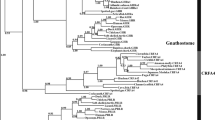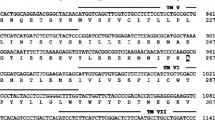Abstract
Two cognate hormones, growth hormone (GH) and somatolactin (SL), control several important physiological processes in vertebrates. Knowledge about GH and its receptor (GHR) has accumulated over the last decades. However, much less is known about SL and its receptor (SLR). SL is found only in fish (including lungfish), suggesting that it was present in the common ancestor of vertebrates, but was lost secondarily in the lineage leading to land vertebrates after the lungfish branched off. SLR was suggested to be a duplicated copy of GHR acquired only in teleosts via the fish-specific genome duplication (FSGD). This scenario (i.e., the existence of SL but not SLR in the vertebrate ancestors) is intriguing but contested. In this study, we first evaluated the plausibility of this scenario through synteny analyses and found that the loci for GHR and SLR are located in syntenic genomic positions, whereas the loci for GH and SL are not. Next, we cloned GHRs of lungfish and sturgeon, which possess SL but did not undergo the FSGD (i.e., they should not possess SLR). Their phylogenetic positions in the GHR/SLR gene tree further support the fish-specific scenario for the GHR–SLR duplication. Interestingly, their sequences share greater similarity with teleost SLRs and reptilian/amphibian GHRs than with the GHRs of mammals, birds, and teleosts. On the basis of these results, we discuss the validity of the nomenclature of the teleost-specific copy of GHR as SLR and an ancestral receptor(s) for SL before the evolution of SLR during the FSGD.









Similar content being viewed by others
References
Abascal F, Zardoya R, Posada D (2005) ProtTest: selection of best-fit models of protein evolution. Bioinformatics 21:2104–2105
Agarwal SK, Cogburn LA, Burnside J (1994) Dysfunctional growth hormone receptor in a strain of sex-linked dwarf chicken: evidence for a mutation in the intracellular domain. J Endocrinol 142:427–434
Amemiya Y, Sogabe Y, Nozaki M, Takahashi A, Kawauchi H (1999) Somatolactin in the white sturgeon and African lungfish and its evolutionary significance. Gen Comp Endocrinol 114:181–190
Brown RJ, Adams JJ, Pelekanos RA, Wan Y, McKinstry WJ, Palethorpe K, Seeber RM, Monks TA, Eidne KA, Parker MW, Waters MJ (2005) Model for growth hormone receptor activation based on subunit rotation within a receptor dimer. Nat Struct Mol Biol 12:814–821
Clackson T, Wells JA (1995) A hot spot of binding energy in a hormone-receptor interface. Science 267:383–386
Clackson T, Ultsch MH, Wells JA, de Vos AM (1998) Structural and functional analysis of the 1:1 growth hormone:receptor complex reveals the molecular basis for receptor affinity. J Mol Biol 277:1111–1128
de Vos AM, Ultsch M, Kossiakoff AA (1992) Human growth hormone and extracellular domain of its receptor: crystal structure of the complex. Science 255:306–312
Dos Santos C, Essioux L, Teinturier C, Tauber M, Goffin V, Bougneres P (2004) A common polymorphism of the growth hormone receptor is associated with increased responsiveness to growth hormone. Nat Genet 36:720–724
Force A, Lynch M, Pickett FB, Amores A, Yan YL, Postlethwait J (1999) Preservation of duplicate genes by complementary, degenerative mutations. Genetics 151:1531–1545
Fukada H, Ozaki Y, Pierce AL, Adachi S, Yamauchi K, Hara A, Swanson P, Dickhoff WW (2004) Salmon growth hormone receptor: molecular cloning, ligand specificity, and response to fasting. Gen Comp Endocrinol 139:61–71
Fukada H, Ozaki Y, Pierce AL, Adachi S, Yamauchi K, Hara A, Swanson P, Dickhoff WW (2005) Identification of the salmon somatolactin receptor, a new member of the cytokine receptor family. Endocrinology 146:2354–2361
Fukamachi S, Sugimoto M, Mitani H, Shima A (2004) Somatolactin selectively regulates proliferation and morphogenesis of neural-crest derived pigment cells in medaka. Proc Natl Acad Sci U S A 101:10661–10666
Fukamachi S, Yada T, Mitani H (2005) Medaka receptors for somatolactin and growth hormone: phylogenetic paradox among fish growth hormone receptors. Genetics 171:1875–1883
Fukamachi S, Wakamatsu Y, Mitani H (2006) Medaka double mutants for color interfere and leucophore free: characterization of the xanthophore–somatolactin relationship using the leucophore free gene. Dev Genes Evol 216:152–157
Gomi M, Sonoyama M, Mitaku S (2004) High performance system for signal peptide prediction: SOSUIsignal. Chem Bio Informat J 4:142–147
Guindon S, Gascuel O (2003) A simple, fast, and accurate algorithm to estimate large phylogenies by maximum likelihood. Syst Biol 52:696–704
Goujon L, Allevato G, Simonin G, Paquereau L, Le Cam A, Clark J, Nielsen JH, Djiane J, Postel-Vinay MC, Edery M, et al. (1994) Cytoplasmic sequences of the growth hormone receptor necessary for signal transduction. Proc Natl Acad Sci U S A 91:957–61
Hansen LH, Wang X, Kopchick JJ, Bouchelouche P, Nielsen JH, Galsgaard ED, Billestrup N (1996) Identification of tyrosine residues in the intracellular domain of the growth hormone receptor required for transcriptional signaling and Stat5 activation. J Biol Chem 271:12669–12673
Harding PA, Wang XZ, Kelder B, Souza S, Okada S, Kopchick JJ (1994) In vitro mutagenesis of growth hormone receptor Asn-linked glycosylation sites. Mol Cell Endocrinol 106:171–180
Hoegg S, Meyer A. (2005) Hox clusters as models for vertebrate genome evolution. Trends Genet 21:421–424
Ito M, Matsuo Y, Nishikawa K (1997) Prediction of protein secondary structure using the 3D-1D compatibility algorithm. Comput Appl Biosci 13:415–424
Jiao B, Huang X, Chan CB, Zhang L, Wang D, Cheng CH (2006) The co-existence of two growth hormone receptors in teleost fish and their differential signal transduction, tissue distribution and hormonal regulation of expression in seabream. J Mol Endocrinol 36:23–40
Kajimura S, Kawaguchi N, Kaneko T, Kawazoe I, Hirano T, Visitacion N, Grau EG, Aida K (2004) Identification of the growth hormone receptor in an advanced teleost, the tilapia (Oreochromis mossambicus) with special reference to its distinct expression pattern in the ovary. J Endocrinol 181:65–76
Keane TM, Creevey CJ, Pentony MM, Naughton TJ, Mclnerney JO (2006) Assessment of methods for amino acid matrix selection and their use on empirical data shows that ad hoc assumptions for choice of matrix are not justified. BMC Evol Biol 6:29
Kumar S, Tamura K, Nei M (2004) MEGA3: Integrated software for Molecular Evolutionary Genetics Analysis and sequence alignment. Brief Bioinform 5:150–163
Laron Z (2004) Laron syndrome (primary growth hormone resistance or insensitivity): the personal experience 1958–2003. J Clin Endocrinol Metab 89:1031–1044
Lee LT, Nong G, Chan YH, Tse DL, Cheng CH (2001) Molecular cloning of a teleost growth hormone receptor and its functional interaction with human growth hormone. Gene 270:121–129
May D, Alrubaian J, Patel S, Dores RM, Rand-Weaver M (1999) Studies on the GH/SL gene family: cloning of African lungfish (Protopterus annectens) growth hormone and somatolactin and toad (Bufo marinus) growth hormone. Gen Comp Endocrinol 113:121–135
Meyer A, Schartl M (1999) Gene and genome duplications in vertebrates: the one-to-four (-to-eight in fish) rule and the evolution of novel gene functions. Curr Opin Cell Biol 11:699–704
Meyer A, Van de Peer Y (2005) From 2R to 3R: evidence for a fish-specific genome duplication (FSGD). Bioessays 27:937–945
Mindell DP, Meyer A (2001) Homology evolving. Trends Ecol Evol 16:434–440
Mitani H, Kamei Y, Fukamachi S, Oda S, Sasaki T, Asakawa S, Todo T, Shimizu N (2006) The medaka genome: Why we need multiple fish models in vertebrate functional genomics. In: Volff J-N (eds). Genome dynamics, vol 2. Karger, Basel, pp. 165–182
Moghadam HK, Ferguson MM, Danzmann RG (2005) Evidence for Hox gene duplication in rainbow trout (Oncorhynchus mykiss): a tetraploid model species. J Mol Evol 61:804–818
Ozaki Y, Fukada H, Kazeto Y, Adachi S, Hara A, Yamauchi K (2006) Molecular cloning and characterization of growth hormone receptor and its homologue in the Japanese eel (Anguilla japonica). Comp Biochem Physiol B Biochem Mol Biol 143:422–431
Postlethwait J, Amores A, Cresko W, Singer A, Yan YL (2004) Subfunction partitioning, the teleost radiation and the annotation of the human genome. Trends Genet 20:481–490
Postlethwait JH (2006) The zebrafish genome in context: ohnologs gone missing. J Exp Zoolog B Mol Dev Evol 308B:563–577
Robinson-Rechavi M, Laudet V (2001) Evolutionary rates of duplicate genes in fish and mammals. Mol Biol Evol 18:681–683
Ronquist F, Huelsenbeck JP (2003) MrBayes 3: Bayesian phylogenetic inference under mixed models. Bioinformatics 19:1572–1574
Saera-Vila A, Calduch-Giner JA, Perez-Sanchez J (2005) Duplication of growth hormone receptor (GHR) in fish genome: gene organization and transcriptional regulation of GHR type I and II in gilthead sea bream (Sparus aurata). Gen Comp Endocrinol 142:193–203
Somers W, Ultsch M, de Vos AM, Kossiakoff AA (1994) The X-ray structure of a growth hormone-prolactin receptor complex. Nature 372:478–481
Souza SC, Frick GP, Wang X, Kopchick JJ, Lobo RB, Goodman HM (1995) A single arginine residue determines species specificity of the human growth hormone receptor. Proc Natl Acad Sci USA 92:959–963
Taniguchi Y, Takeda S, Furutani-Seiki M, Kamei Y, Todo T, Sasado T, Deguchi T, Kondoh H, Mudde J, Yamazoe M, Hidaka M, Mitani H, Toyoda A, Sakaki Y, Plasterk RH, Cuppen E (2006) Generation of medaka gene knockout models by target-selected mutagenesis. Genome Biol 7:R116
Tse DL, Tse MC, Chan CB, Deng L, Zhang WM, Lin HR, Cheng CH (2003) Seabream growth hormone receptor: molecular cloning and functional studies of the full-length cDNA, and tissue expression of two alternatively spliced forms. Biochim Biophys Acta 1625:64–76
Very NM, Kittilson JD, Norbeck LA, Sheridan MA (2005) Isolation, characterization, and distribution of two cDNAs encoding for growth hormone receptor in rainbow trout (Oncorhynchus mykiss). Comp Biochem Physiol B Biochem Mol Biol 140:615–628
Yang Z (1997) PAML: a program package for phylogenetic analysis by maximum likelihood. Comput Appl Biosci 13:555–556
Yi S, Bernat B, Pal G, Kossiakoff A, Li WH (2002) Functional promiscuity of squirrel monkey growth hormone receptor toward both primate and nonprimate growth hormones. Mol Biol Evol 19:1083–1092
Zhang Y, Jiang J, Kopchick JJ, Frank SJ (1999) Disulfide linkage of growth hormone (GH) receptors (GHR) reflects GH-induced GHR dimerization. Association of JAK2 with the GHR is enhanced by receptor dimerization. J Biol Chem 274:33072–33084
Zhou Y, Xu BC, Maheshwari HG, He L, Reed M, Lozykowski M, Okada S, Cataldo L, Coschigamo K, Wagner TE, Baumann G, Kopchick JJ (1997) A mammalian model for Laron syndrome produced by targeted disruption of the mouse growth hormone receptor/binding protein gene (the Laron mouse). Proc Natl Acad Sci U S A 94:13215–13220
Zhu Y, Stiller JW, Shaner MP, Baldini A, Scemama JL, Capehart AA (2004) Cloning of somatolactin alpha and beta cDNAs in zebrafish and phylogenetic analysis of two distinct somatolactin subtypes in fish. J Endocrinol 182:509–518
Zhu Y, Song D, Tran NT, Nguyen N (2007) The effects of the members of growth hormone family knockdown in zebrafish development. Gen Comp Endocrinol 150:395–404
Acknowledgments
The authors would like to thank S. Hoegg of the University of Konstanz and J. G. Inoue of Florida State University for the lungfish and sturgeon samples, and for advice on the phylogenetic reconstruction; Y. Minegishi and J. Aoyama of the University of Tokyo for the eel genomic DNA; Y. Ozaki of National Institute of Genetics and H. Fukada of Kochi University for detailed information about the eel GHR; and D. Gerrard for the idea of the relative-rate test and comments on the manuscript. The authors would also like to thank H. Mitani of the University of Tokyo and T. Yada of the National Research Institute of Fisheries Science for comments on the manuscript. This research was supported by a long-term fellowship (#LT00059/2005-L) from the International Human Frontier Science Program Organization to S.F., and grants from the Deutsche Forschungsgemeinschaft and the University of Konstanz to A.M.
Author information
Authors and Affiliations
Corresponding author
Rights and permissions
About this article
Cite this article
Fukamachi, S., Meyer, A. Evolution of Receptors for Growth Hormone and Somatolactin in Fish and Land Vertebrates: Lessons from the Lungfish and Sturgeon Orthologues. J Mol Evol 65, 359–372 (2007). https://doi.org/10.1007/s00239-007-9035-7
Received:
Revised:
Accepted:
Published:
Issue Date:
DOI: https://doi.org/10.1007/s00239-007-9035-7




